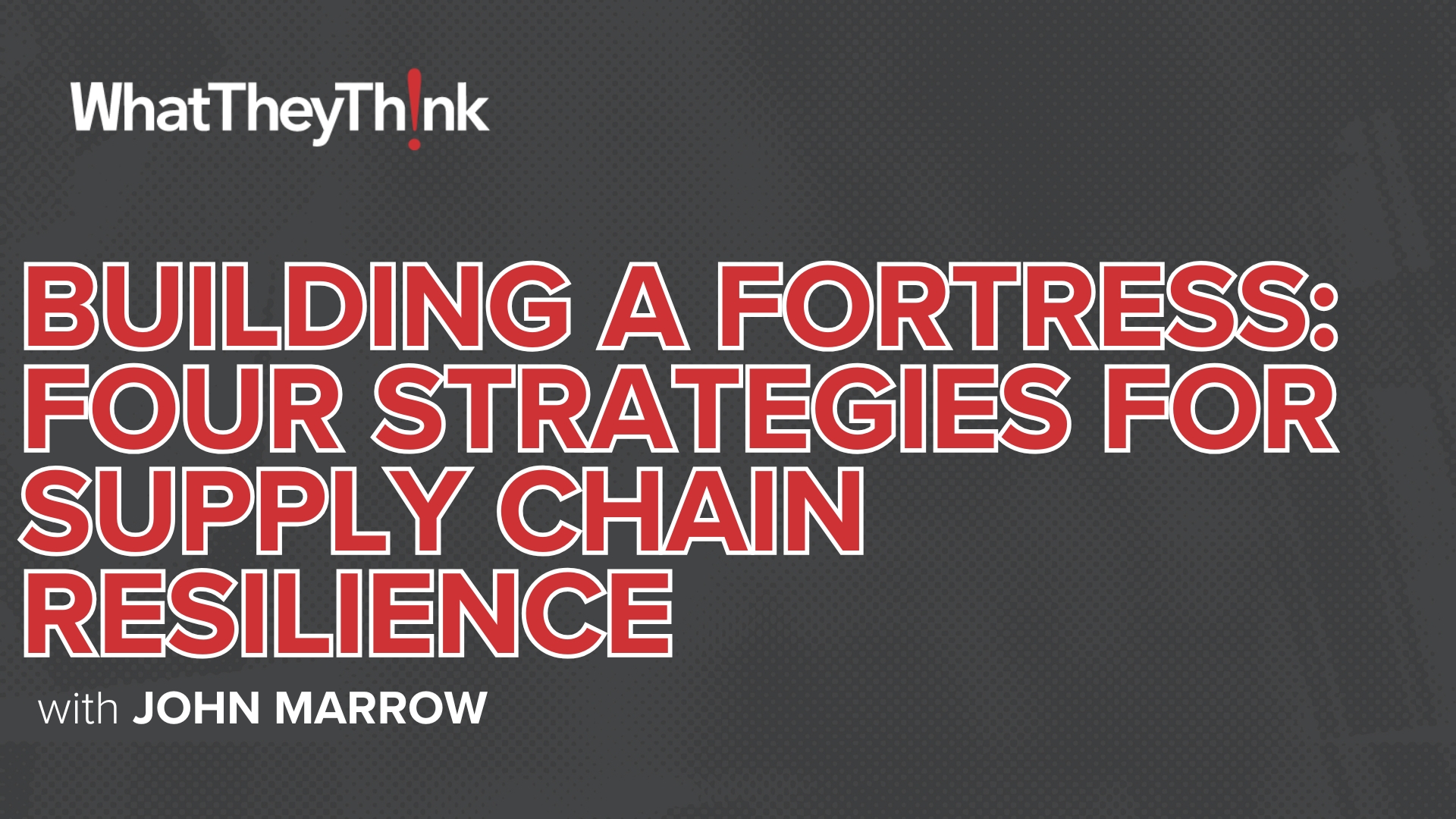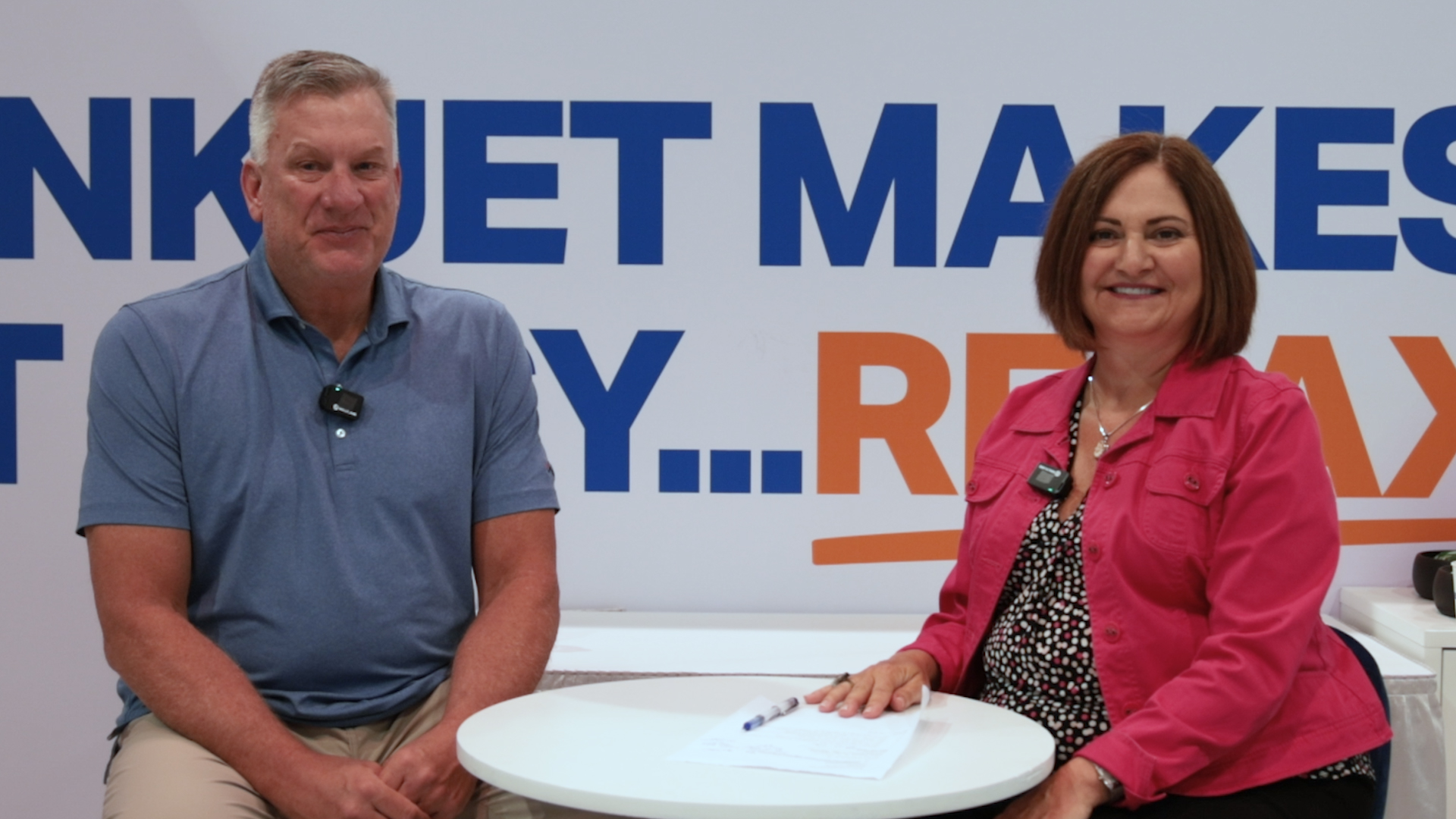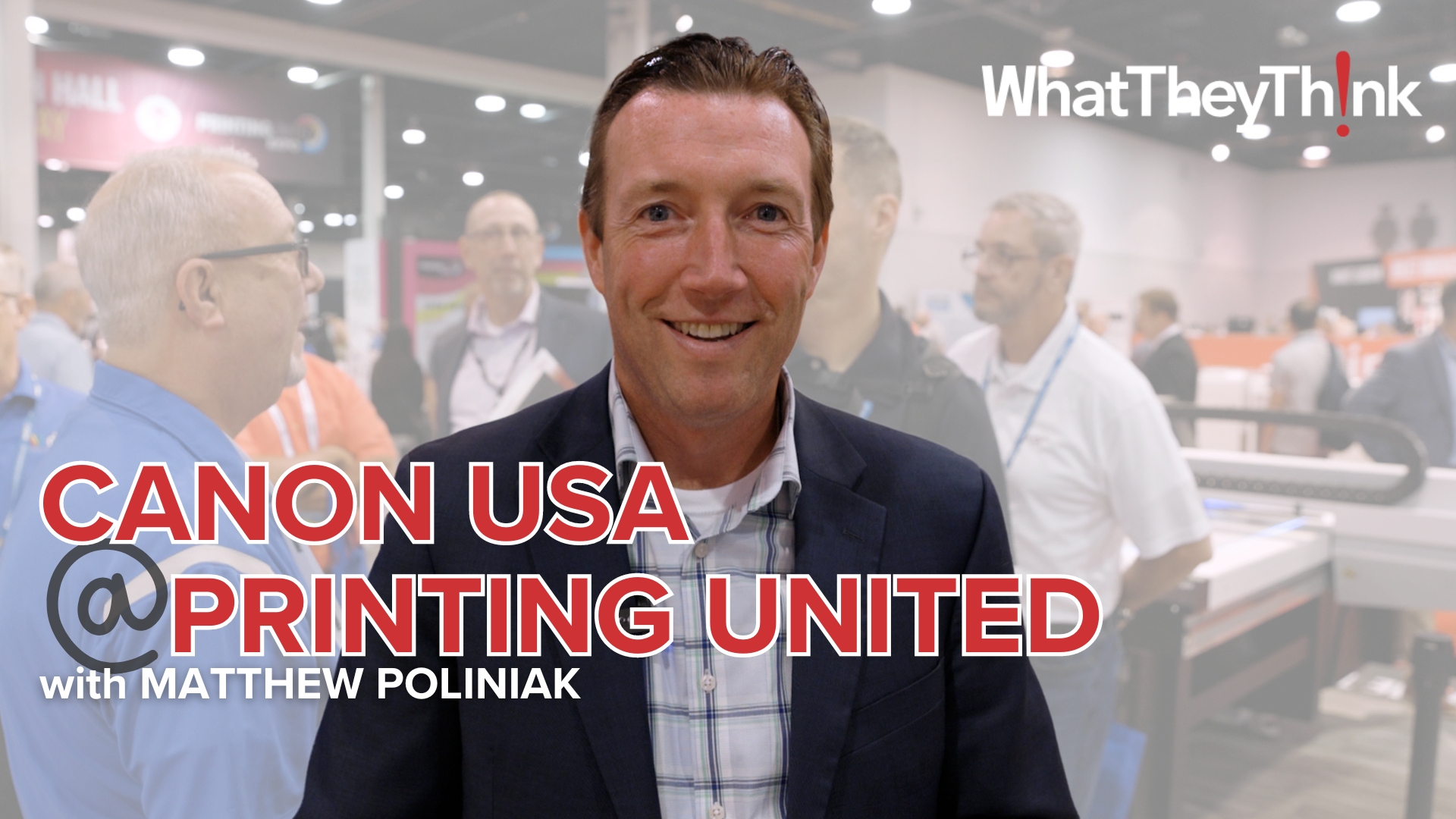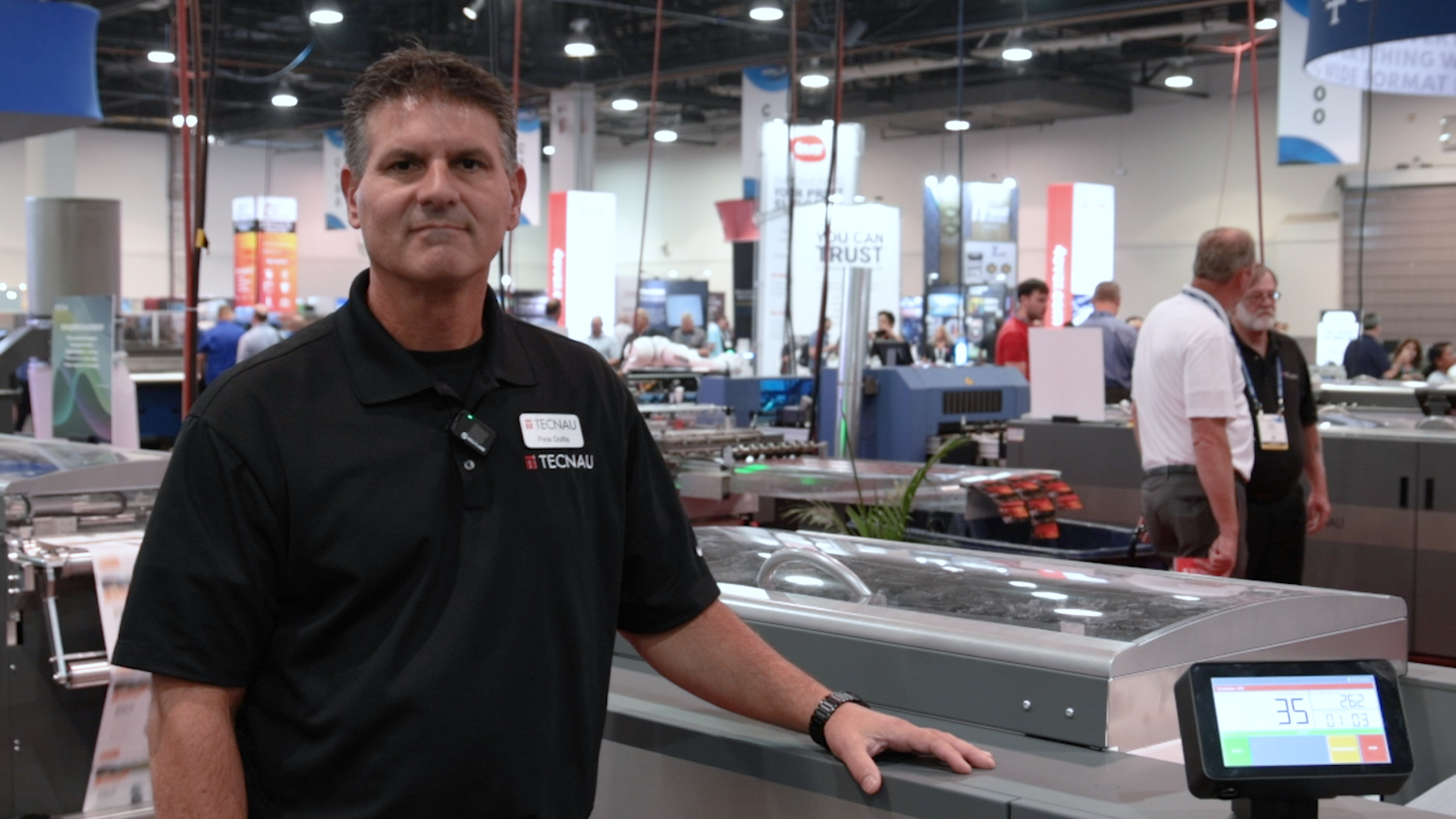Commentary & Analysis
Displaying 4651-4750 of thousands of articles
Insight You Need. Analysis You Trust.
Get the trusted insights you need to understand our evolving industry and emerging trends. Become a Premium Member.
BR Printers Colors the World of Black & White
BR Printers discusses how production inkjet printing is changing the way the company does business and opening up new business opportunities in a highly competitive marketplace. This article is sponsored by HP.
Is Your Print MIS Your Trusted System of Record?
Whether you have recently acquired a new Print MIS system or you’ve been using the same one for a decade, we recommend you assess it as the “trusted system of record” for your print business. This assessment is critical in our increasingly data-driven world.
Not Sure How to Recycle That Package? Look at the Label
The How2Recycle Label is a much-needed visual cue in the right place at the right time.
Print MIS and Data are NOT Boring
Nobody uses terms like exciting, sexy, or compelling when they talk about their Print MIS solution. Your Print MIS isn’t supposed to be sexy; its job is to serve up the story of your business in the form of data collected in a trusted system of record.
What’s My Line? Some Labelers Say, “Linerless”
Eliminate the peel-away part of a pressure sensitive label while protecting it from the adhesive on the backs of the other labels it’s rolled or stacked with: it can be done and is being done in the solution known as linerless labeling.
Software Investment Trends and the Return of Color Management
This article explores the increased interest in color management software among corporate and commercial printers. It cites research from InfoTrends to illuminate how more and more businesses are beginning to recognize the benefits of implementing a color management program.
NFIB Small Business Index Falls
The monthly NFIB Small Business Index took a step back after it nearly reached the pre-recession high. The chart shows that high of a few years ago as a green line. The index fell almost to the bottom of the 2003 recession level. For a few years the Index seemed range-bound between that recession and the lows of the recession of the early 1990s (the two red lines). This particular survey had all ten elements of its index fall, which is highly unusual. The Index bears watching as there are very few data series that follow small business activity.
ISA’s Sign Expo Goes Beyond "Sign and Display"
The International Sign Association’s Sign Expo took place last week in Las Vegas, NV. Richard Romano files his observations from the show.
Print Estimating & Quoting System Product Spotlight: arifiQ
Self-service is a growing preference among customers, pricing transparency is a feature of our online world, and speed is a growing differentiator in all aspects of our business. arifiQ has focused on a pivotal function of print – estimating/quoting; enabling printers to adapt to the new realities of our increasingly digital, online, and fast-paced business environment.
Print’s Representation at the MarTech Conference
MarTech – the Marketing Technology Conference took place March 31, 2015 in San Francisco. I attended to see how print is being represented within the modern marketing mix.
How MarTech Impacts Commercial Printing Business
Industry Analyst Junichiro Yamashita recently attended the MarTech Conference in San Francisco to learn about the latest trends in Marketing Technology (MarTech). He shares his thoughts with our readers about the opportunities and challenges MarTech provides for Commercial Printers.
Vistaprint Hits a Double with Global Acquisition Strategy – March 2015 M&A Activity
March 2015 –Mergers, Acquisitions & Restructuring in the Printing, Packaging & Related Industries.
Online Marketing for Printers
You haven’t updated your website in over two years. You don’t remember if you have a LinkedIn page, you thought someone once tweeted something, and you recently had a customer complain about not being able to find you online.
HP’s New Single-Pass Printer Portfolio
Yesterday, on the eve of the opening of the ISA Sign Expo, HP took the opportunity to launch five new products in its high-end Latex and Scitex families. These are the HP Latex 370, the HP Scitex FB550 and FB750, HP Scitex 11000 Industrial Press, and HP Scitex 15500 Corrugated Press.
Are You Doing Your Part to Make Sure PRINT’S VOICE Is Being Heard in Washington?
Do you know about the joint NPES/PIA program for raising Print’s Voice in the Nation’s Capital? We all complain about Congress not getting anything done, but how many of US actually do anything about it? Here’s a great program that gets the word out about print and pokes at Congress to get stuff done.
Reinventing Your Business: It’s about Telling Your Story!
Because of new and emerging technologies, today’s business owners face a whole new set of challenges. According to Josh Linkner’s book entitled The Road to Reinvention, the way that you position your company and communicate to your various audiences and target markets is a critical component of transforming your business. This article highlights real-world examples of how the art of storytelling can help accelerate businesses transformation.
Number of Employees per US Commercial Printing Establishment
The average number of employees in commercial printing establishments has declined over the years for many reasons. Among large printers, volumes of magazines, catalogs, inserts, and other long run length products produced on web offset and gravure presses have declined, leading to plant closures and consolidations. Desktop publishing shifted work to graphic designers, publishers, and other content creators. That, combined with direct-to-plate and digital printing have nearly eliminated the need for prepress departments. Presses require less staffing than older ones. In smaller printers, copies and digital printers have reduced the need for press operators. Other technologies, such as search engines, e-commerce, advances in administrative software have reduced employment in other functions. Even voice mail, cell phones, and e-mail have gradually reduced the number of staff required to run a printing business.
Adobe Tackles Next-Generation Digital Publishing with Summer Launch of Adobe Publish
We’ve written a fair amount about digital publishing in this space since we believe it presents a good opportunity for new revenue streams for printing firms – not only for traditional publishing applications but increasingly for sales enablement and other enterprise dissemination of information. Adobe is about to take this to the next level with its summer launch of Adobe Publish.
Brother and Domino: An Important New Combination in Industrial Printing
With its acquisition of Domino Printing Sciences, Brother Industries has made a strong move into industrial inkjet printing with applications including high-speed, full-color label production.
Data-Driven: Thriving Print Business in 2020
A data-driven print business starts with a trusted system of record and then as selected meaningful metrics that influence your business decisions and your staff’s daily behavior.
Find Big Challenges - The Sixth Rule of Social Selling
Your role is to enable your customers to meet their needs, grasp their opportunities, and defend against their threats. Whether you like it or not that’s how your customers see your role. If you’re not doing one of those three things, you’re a distracting and useless waste of time. Period.
“Dear Packaging, I Hate You”
When designers forget that that the product experience, not the act of opening the package, is what consumers are paying for, things can get stressful.
Earn Your Access – Fifth Rule of Social Selling
Direct, early access to the real decision-maker – not someone whose power is limited to saying “no,” but the person who has the authority to say the final “Yes” – It’s the Holy Grail for professional B2B salespeople. And it has gotten harder and harder to gain.
Is it Time to Reinvent Your Business? Can You Afford NOT To?
The relentless pace of change is exacerbating the challenges that business owners face today. According to Josh Linkner’s book entitled The Road to Reinvention, leading companies are disrupting the status quo to achieve growth and economic gain. This article explores how businesses can take Linkner’s advice to avoid losing ground.
Know Your Wide Format Inks!
Herein a basic primer on today’s ink options for wide-format printing, from solvent and eco-solvent to UV, from latex to dye-sublimation.
Enrich Your Network – Fourth Rule of Social Selling
One common trait is shared by all of the highest-performing salespeople I know. Each one works steadily and intentionally to increase his or her Sphere of Influence.
Winston Packaging Moves Into Its Second Century With a Speed Record and a Winning Game Plan
This North Carolina packaging printing firm has earned its place in a demanding market through stringent quality control, smart technology investments, and ultra-efficient production workflows.
Online Engagement: Thriving Print Business in 2020
The online channel is in the language of the customer and you have to compete to be found. These fundamental characteristics of this channel should drive your online presence at every level.
Sharpen Yourself! – The Third Rule of Social Selling
Some B2B salespeople I encounter baffle me. My work brings dozens of them across my path each year. There’s a significant segment who claim to desire and expect productive careers but who show almost no sign of investing in themselves. I don’t get it.
2nd Rule of Social Selling - Reject Funnelism
I have a confession to make. I’m not a Funnelist. I don’t worship at the altar of Funnelism. Never have. It's deadly. Ben Chestnut (founder of MailChimp) was right when he compared the “marketing funnel” to a meat grinder.
Sales and Marketing: An Investment, Not an Expense!
Proactive sales and marketing investments are vital to growing and driving business results. Citing research from McKinsey and Company, this article explores strategies for building superior marketing and sales capabilities.
Real Interest Rates are Rising, Thanks to Low Inflation
The chart shows one of the rates for Treasury securities called the “constant maturity rate,” used to set rates for instruments like mortgages. The line in the chart is that monthly rate less the year-to-year change in the Consumer Price Index for that month. The Fed has worked hard to keep their interest rates below inflation to stimulate the economy, as well as make housing prices rise so that fewer mortgages were “under water.” It hasn't worked that well, but that's a different topic for a different day. But with all of the worries about the Fed raising rates, the combination of their inertia and changes in the inflation rate may be producing what they've wanted: a Seinfeldian case of “nothing” becoming something. At the end of 2011 the real rate in the chart was -3%, and the last observation in the chart is about +1.5%, a 450 basis point move. For about three years, the CPI has been below the Fed's target of 2%, and in December and January it was negative. February CPI was just reported as an annualized 2.4%, so this rate rise may disappear soon
Sustainable and Green: Do I Still Need to Worry About Compliance?
Standards for “green” or eco-friendly printed products and processes are still in flux, and don’t always gibe with environmental compliance reporting requirements. It pays to know what the differences are.
Social Selling: Rule #1 – Don’t Be Creepy
The horror in his face made me laugh out loud. I was in a videoconference coaching session with a VP, Sales & Marketing. I was coaching some of his salespeople and to track with them, he was doing with me what they were doing. He and I had designed a new business development process from the ground up, and were vetting each stage and step. We were deep into the process, and focused on how to gain access to a decision-maker.
Packaging Plants Are on the Rise
While we are waiting for flowers to bloom in the spring, we can admire the recent crop of plant openings or expansions in various segments of the packaging industry.
CRON-ECRM Joint Venture Declares Bid for Leadership in CTP
A Chinese computer-to-plate systems manufacturer and an American counterpart have joined forces to offer CTP devices that they say are as good as if not better than any other such solutions now on the market.
Production Inkjet—The Next Wave: It’s not a wave; it’s an explosion!
In this article, David reviews how four companies are using the technologies he has been reviewing to their advantage. Wilen Direct, K&H Integrated Print Solutions, Hansaprint and Documation have implemented current generation inkjet presses from Kodak, Canon Océ, HP and Ricoh, respectively
Thriving Print Business in 2020: Diversified, Online, and Data-Driven
Expand your thinking in many directions, beyond the four walls of your manufacturing operations, beyond your business into your customer’s business, and beyond print to the other communication methods that are complimentary to print.
GASC’s Ralph Nappi on Moving Graph Expo to Orlando
On the face of it, all the GASC announcement says is that there will be a one-year detour to Orlando between now and 2017, when the Print show will have its prescheduled run at McCormick Place in Chicago. That’s also where we’ll be heading for Graph Expo this year—no change there, either. So, what’s the larger story?
Web-to-Print: The Best or Worst Investment?
Some print service providers are automating production with Web-to-print software, but this strategy does not work for all companies. This article explores why some companies succeed with Web-to-print while others fail.
Crashing at the Finish: The Last, Winning Step Too Many Salespeople Skip
She was so close. She had worked to develop the opportunity for two years. She had created a couple of key relationships, and developed them very well. She had a good understanding of the customer’s circumstances and special needs. With help, she created a strong proposal and delivered it to her primary contact. Her primary contact recommended that her proposal be chosen. So she rightly believed she was in the lead. And then she lost it. Why? She didn't ask for the opportunity to make a presentation before the final decision was made. She thought her excellent proposal was enough.
While The World Listens for a Rate Hike News, the Fed Lowers Their GDP Forecasts
On Wednesday, March 18, the Feb removed the word “patient” from the announcement of a potential rate hike, but as the Washington Post explained “Well, the Fed really said that it's going to be more patient than it was before, even if it's not officially so. In other words, it could hike rates at any time starting in June, but it's less likely to do so. And even when lift off does happen, it'll probably happen slower than people thought it would.” There you have it: Janet Yellen does a great Alan Greenspan impression. No one knows what he meant but everyone knows what he said. Dr. Yellen also explained that while the Fed is no longer in the act of quantitative easing, they are replacing all of their holdings as they mature. What got less coverage is that the Fed lowered their forecasts of GDP. For 2015 and 2016 they lowered their prior forecasts by three-tenths of a percentage point. Each tenth is about $150 billion. So their forecast was reduced by $450 billion, or the equivalent of six commercial printing industries. Such data analogies can make one's head spin.
Hunkeler InnovationDays: 22 Years of Collaborative Success
While many other trade events are struggling to survive in a dynamically changing environment, Hunkeler Innovationdays, which has taken place in Lucerne, Switzerland, every other year for the past 22 years (11th event this year!) has continued to grow in both size and vitality. Here’s an overview of the 2015 event.
Generation Next: Mandel Graphic Solutions Keeps Evolving with Technology
After 123 years and four generations of owners, Milwaukee’s Mandel Graphic Solutions has thrived by staying current.
HP and KBA Take Aim at Corrugated Packaging Market with HP’s T1100 Simplex Color Inkjet Web Press
High, wide, and in its own way, handsome: that’s the kind of machine HP and KBA are out to build in HP’s T1100 Simplex Color Inkjet Web Press, a solution meant to introduce digital printing to top liners for corrugated packaging.
Quad/Graphics CEO Speaks Out about Book Platform Transformation, State of the Industry, Go-Forward Strategy
Quad/Graphics has been in the news a lot of late … first with its agreement to acquire at least 20 HP T-Series Inkjet Web Presses, and then with the attempt to acquire book printer Courier Corporation. Senior Editor Cary Sherburne spoke with CEO Joel Quadracci to get more information and find out what else Quad is up to.
The Role of Marketing in Your Print Business
Marketing is about delivering qualified leads to your sales team. The online world has converted marketing into a role that can be precisely measured. Start thinking of marketing as a role with a quote (# of qualified leads delivered), stop thinking of marketing as your brand colors or business card design.
Who Says Books Aren’t Pretty? – February 2015 M&A Activity
Books were ascendant in the printing deal space as RR Donnelley swooped down and snatched Courier Corporation right out of the arms of Courier’s suitor of choice, Quad/Graphics. Almost two and half times larger than Quad, RRD was not about to let this opportunity escape as it did last year when Quad acquired Brown Printing in a sweetheart of a deal.
Trends to Watch in 2015: Building the Right Infrastructure for Success
Infrastructure includes the basic physical and organizational components that contribute to the success of an organization in terms of the sale and delivery of products, services, and solutions. This article is part of a series exploring trends worth watching in the printing industry. It explores the infrastructure investments that are critical for success in today’s market.
UV Printing: Good as Gold?
Experts identify new and expanding—and some unusual—markets for UV inks and coatings at day two of RadTech’s UV.EB West.
The Labor Market is Very Dynamic
Don't let four jagged lines on a chart confuse you, because there's good news hidden inside. The labor market is very dynamic, more dynamic than commonly understood. About 2% of the workforce quits jobs every month, and between 1.5%-2% separate from their positions in other ways because their projects are completed, fired for cause, or downsizings. About 3% of the workforce is hired in different positions every month. What's made the improvement in total employment this past year is the increase in job openings (the blue line in the chart). Note that it has a higher upward slope than the other lines. The number of job openings is now around 5 million per month, more than double that when the recovery started in mid-2009. The bottom line, in red, is “quits.” Most workers do not quit their jobs unless they have something better lined up. That line has a general upward slope, and it is common for this to increase as economies improve and workers feel more comfortable changing positions. Though not population-adjusted, the lines are definitely moving in positive directions, with job openings as the most encouraging of them. What's this mean to printers? Never consider your business contacts in companies as “safe.” As economies improve, job changing increases. Be sure to have multiple engaged contacts in your most important clients. Also, be sure your key employees are kept “gruntled” because disgruntled key employees can be valuable elsewhere.
Learning the Language of Labeling
The Constantia Flexibles Labels Division of Spear Inc. recently announced that it has found a way to make pressure sensitive labels compatible with recycling methods for bottles molded from PET (polyethylene terephthalate) plastic. This is a breakthrough, says the company, because it offers an affordable and environmentally friendly solution for bring pressure sensitive labeling to the 400 billion PET bottles the world uses annually.
UV.EB West Showcases Current Trends in Radiation Curing Technologies
Ultraviolet (UV) and electron beam (EB) curing technologies have been around for decades, but have continually evolved and are well-suited for today’s modern print and packaging production processes.
Recruiting Salespeople: Stop Hiring Retreads
Yes, I’m talking to you. You knew exactly what I meant when you saw the headline: itinerant salespeople who move from company to company on about a two-year cycle. Of course they hope that this time will be different, that this gig will last. The problem is they are going to sell as they have before while hoping for a different outcome. The companies that hire them reinforce that false hope, and set them up for one more spin through the failure cycle. It's ugly. And it's expensive.
Strategic Gamble on Production Inkjet Pays Off for Liturgical Publications
Facing typical offset run lengths of 750 or less, make-ready waste of as much as 50%, and with evolving customer expectations for more color and higher expectations of color quality and consistency, Liturgical Publications turned to production inkjet as a strategic gamble which has turned into a strategic advantage for this innovative publisher.
The Primacy of Process: an Interview with Heidelberg’s Jürgen Grimm
The most successful packaging printing companies that Jürgen Grimm has seen are the ones that have their processes most thoroughly under control. In this interview, the president of Heidelberg USA talks about how that control can be achieved.
As a Print Owner, Where is Your Focus?
If your focus is all internal, you are missing the broader context of how your products and services are utilized within your customer’s business. Loyal customers are created when you help them achieve their business results, that means engaging with customers in the broader context of their business.
Lla Llama
Not living anywhere near Arizona, I was unaware of the recent “Phoenix Llama Drama,” which is apparently not some new reality TV show. Rather, last month, a brace of the beasts escaped while—and I have to quote ABC News here—“making a therapy visit to residents at an assisted living facility.”
Trends to Watch in 2015: The Innovative Use of Technology
In his book entitled Innovation and Entrepreneurship, Peter F. Drucker states that an entrepreneur “always searches for change, responds to it, and exploits it as an opportunity.” This article explores the ways in which entrepreneurs and service providers can leverage existing technologies to successfully innovate.
Allegra Network, Avanti and Ricoh: The Inside Story
In early February, Ricoh and Avanti announced that Allegra Network had chosen Avanti Slingshot as the core of its WorkStream™ integrated web storefront/MIS/workflow automation solution. Senior Editor Cary Sherburne spoke with the franchisor’s executives to get the details of what this means for franchise members and customers.
Current Dollar GDP and NAICS 323 US Commercial Printing Shipments
There is a general (and natural) assumption that commercial printing and the economy as measured by GDP move together. The chart below shows the year-to-year percentage change of the two data series, GDP in red and printing in blue. The chart tracks current dollars and are not adjusted for inflation. Except for a brief period from the second quarter of 1995 through the first quarter of 1996, shipments have lagged GDP growth. What was special about that period? The Internet bubble was beginning, and in September 1995, Netscape had its initial public offering. For those four quarters, commercial printing was an average of 4.5 percentage points better than GDP growth. Prior to that, commercial printing had lagged GDP during a period of slow economic growth. Since Q2-1996, the difference between nominal, unadjusted GDP and commercial printing has been 5 percentage points. The last two quarters of 2014 commercial printing had positive growth compared to the prior year, but still lagged GDP by -1.6 percentage points.
ISA Gears Up for Biggest Sign Expo Ever
New features, sessions, programs, and speakers at the upcoming International Sign Expo aim to educate present and prospective signmakers about the latest business and technology trends in this growing industry.
Happy 2nd Anniversary, Canon Solutions America!
Senior Editor Cary Sherburne joined a group of 40 journalists and analysts to help Canon Solutions America celebrate its 2nd anniversary and to learn what is new from the organization and where it is going in the future
PRIMIR Research Explores Tag & Label Printing Trends 2013-2018
Flexo claims almost two-thirds of tag & label market production, but some brand owners still view it negatively. By 2018, 50% of installed tag & label presses will be digital. There’s more—keep reading.
Production Inkjet—The Next Wave: Canon Océ VarioPrint i300 Sheetfed Inkjet Press and More
This articles looks at the new Océ VarioPrint i300 sheetfed Production Inkjet press. Additionally, we will take a quick look at the newly announced Océ ImageStream 2400 and the ColorStream 3000Z rollfed presses.
Now What Are You Trying to Sell Me?
The first impressions of your business will be online. How does your online presence compare to you offline presence? Can prospects understand your business and what you can do for them from your website, your blog, and your social media channels? Your online presence sets up your sales team for success.
Is Your Print MIS Testing Your Patience?
In today’s world of instant gratification, it is really hard to be patient. Rather than walking down the hall to talk to your colleague, you can email them from 20 feet away and then march down the hall 15 minutes later to say “didn’t you get my email?”. In the information age, most of us have forgotten what it’s like to not be instantly connected whether we are on vacation, in a restaurant and now even on planes. It has largely destroyed our ability to be patient.
Is There a Case to Be Made for “CPOs”? Kodak Thinks So
By now, you may have heard about Kodak’s ChiefPackagingOfficer, a new online resource for packaging professionals. If you haven’t, its publisher, Joshua Fedeli, wants you to know why the portal is worth your time, attention, and participation.
Trends to Watch in 2015: Wearables (Really!)
Although wearable technologies are still in the early adopter phase, the power of connectivity is driving change at an unprecedented rate. With the information available from wearables, marketers will be able to understand context and generate much more relevant messages. This article is part of a series exploring trends worth watching in the printing industry.
St. Louis Adjusted Monetary Base (The Fed's Balance Sheet)
The Fed stopped Quantitative Easing a while ago, and the value of its balance sheet fluctuates around the $4 trillion level. As their holdings mature, their aggressive position in the bond market will slowly unwind. Or will it? The Fed is likely to decide to re-invest proceeds in more bonds and obligations, replacing the matured debt with new ones, but not adding to their overall position unless there is a crisis again. Until their first moves where they doubled their balance sheet quickly, from $800 billion to $1.6 trillion, this measure of the money supply moved steadily at about a 6% annual rate, sometimes a little more, sometimes a little less, about half equal to economic growth and the other half to inflation. Whether or not the Fed will reduce its balance sheet or not is still a question in my mind. They could just hold steady, and let inflation and growth catch up to them, which will take quite some time, but not scare the markets. But something always happens that's not according to plan, and the Fed will be interesting to watch as they move from this unchartered territory to another.
There Goes the Neighborhood: How To Cope with Commoditization in Wide-Format Printing
Improving technology is causing some wide-format applications to experience that dreaded word “commoditization.” How can print providers fight against it? Can they? Or—most importantly—should they?
Production Inkjet—The Next Wave: Xerox Rialto 900 Inkjet Press
The last time we took a good look at Impika inkjet offerings was prior to drupa 2012 and the Xerox acquisition. Since that last article, Xerox has integrated the Impika organization into the Xerox organization, its former offerings into the Xerox portfolio and now into the Xerox master brand. With the announcement of the Xerox Rialto 900 Inkjet Press, Xerox is releasing the first true collaborative effort following the acquisition.
Parenting and Your Print MIS
Parenting and your print MIS have many characteristics in common. They are both long-term investments that essentially never end. There is great potential combined with great frustration and common stages that you will pass through before feeling any sense of accomplishment – always in retrospect.
Printing Industry Capital Investment, 2003 to 2013
The US Department of Commerce issued their latest report about capital investment spending in 2013, and we've written about it in a recent blogpost. As part of our analysis, we applied the rate of investment to industry shipments and arrived at the chart below. It shows two rather distinct periods, 2003 to 2007, where capital investment was not as good as the late 1990s, but recovered and stabilized after the first negative wave of digital media. Some of this was replacement of late 1990s equipment that had come off lease. Then there's the 2008 credit crisis and recovery. Capital investment declined in volume as industry shipments fell from the introduction of social media, new devices, and cheaper and faster communications. But the rate of capital investment is slowly rising, even though shipments are shrinking, and the number of plants is contracting. The survivors tend to be healthier establishments, who survived the downturns, and are likely making better investment decisions.
A Good Problem to Have? Managing Capacity When Volume Peaks
Capacity management has proven to be a challenge for many wide-format print businesses, especially as many jobs are specialized or customized in some way. What are the ways that shops are coping with this “pain point”?
World Bank Group’s Printing & Multimedia Touts Production Inkjet as a Game-Changer
Jimmy Vainstein, senior project manager of the World Bank Group’s Printing & Multimedia explains how investing in a production inkjet printing solution has revolutionized the institution’s business and increased its value to Bank Group clients.
What’s New at “the New MBO” Packaging Production, Among Other Things
Say “MBO” to anyone in the industry, and the reply will be “folders.” That answer still passes the word association test, but it’s far from being the full story of what this diversified supplier of graphic equipment now has to offer printers and packagers.
Are You Going to TAGA?
While the TAGA Annual Technical Conference doesn’t draw huge crowds, it should. Senior Editor Cary Sherburne speaks with Printing Industries of America’s Dr. Mark Bohan about this year’s program featuring new ideas and solutions for growth.
Radical vs. Incremental Change with Web-to-Print and Print MIS
Do you approach change as an incremental, keep everyone comfortable manner? Or do you see how much the external conditions have changed while your company has stayed still? Is your print software able to support your current and future business needs?
Trends to Watch in 2015: Will This Be the Year of Marketing Automation?
Marketing personnel will be more accountable than ever before for generating sales results. Marketing automation software can dramatically increase leads and profit, and it also provides a greater return on investment in relation to conventional marketing platforms. This article is part of a series exploring trends worth watching in the printing industry.
EFI Connect: Bigger and Better than Ever
2015 saw a bigger and better EFI Connect, with more than 1,000 customers in attendance and a total attendance of more than 1,500 people. As usual, the conference featured many educational sessions and outstanding keynotes. But there were some differences this year.
Printing Employment Data Revised Up in 2014
Every February, the Bureau of Labor Statistics (BLS) updates employment data for the prior year and beyond. This year, the revisions to printing industry employment went back to April 2013. When the BLS calculates employment, especially for industries, it uses estimation methods because actual data are not readily available. That actual data are derived from the Social Security tax filings of employers. In this case, the BLS was underreporting employment, especially in mid-2014. Employment data are used as an input into Commerce Department data for the estimation of industry shipments. Those new employment data, though not released publicly, were probably used in recent months shipment calculations when 2014 shipments began to have favorable comparisons to 2013. It is possible, based on these data, that 2014 industry shipments will be revised up in the annual mid-May shipment revision report. An educated guess would put the change at approximately $1 billion, bringing shipments from +0.2% in current dollars to about +1.5%, or flat with 2013 after adjusting for inflation. Nonetheless, employment in December 2014 was less than December 2013. As can be seen in the chart, January 2015 employment is reported as dropping considerably. January and February tend to be slow months, and March can be one of the best. February employment may rise in anticipation.
The Water “Bottle” You Can “Eat,” and Other Definition-Stretchers
What does a package do? It contains, protects, transports, and identifies what’s inside it. That’s the neat, four-cornered functional description of a package. Here are some edgier ones—and a couple that don’t have edges at all.
End of the Line for MeadWestvaco – January 2015 M&A Activity
Paper and packaging industry giant MeadWestvaco appears to be at the end of its life as an independent entity. The company agreed to a merger with RockTenn to form a yet-to-be-named successor company. RockTenn’s expertise in kraft paper, corrugated cartons and retail displays will combine with MeadWestvaco’s strengths in paperboard and folding cartons. The result will be a powerful player in the increasingly global packaging industry, with over $15 billion in annual revenues.
Technical Printing Sends Print-for-Pay Providers Back to the Drawing Board
Technical printing—graphics that serve the architectural, engineering, and construction markets—has been changing in both positive and negative ways, and “reprographics” shops are changing with the times. And it’s not always just about the equipment.
“Radius” of Label and Packaging Capability Grows Longer Within New EFI Enterprise Packaging Suite
Radius software for MIS/ERP has been at work in label and packaging printing plants for many years. Now part of EFI, Radius will significantly expand its toolkit within a new framework called EFI Enterprise Packaging Suite.
Own Your Print Software: Web-to-Print and Print MIS
Let’s get one thing perfectly clear, you DO NOT invest in print software to run your business as it is today. The whole point of software is to enable you to run your business differently - creating more efficiency.
Production Inkjet—The Next Wave: HP High Definition Nozzle Architecture
As expected, but still exciting to see, another Next Wave production inkjet print technology has been introduced. This one is from HP, and it continues to show that they haven’t been sitting idle in the time since we last took a good look at their production inkjet offerings.
Magnum Force
There has been a surge of growth in what are called “large-format wine bottles.” Magnums, essentially (or would that be “magna”?), or wine bottles greater than 750ml. Indeed, popular sizes include 1.5 liters, 3 liters, and 6 liters. Now, obviously, some of these are intended for parties and other events with large gatherings, not a quiet romantic dinner for two, lest it descend into drunken anarchy (which depends on your approach to dating, I guess).
Trends to Watch in 2015: Delivering an Interactive Customer Experience
At the heart of nearly differentiation strategy are techniques for enhancing the overall customer experience. By improving the customer experience, organizations hope to increase customer satisfaction and boost loyalty. This article is part of a series exploring trends worth watching in the printing industry.
Digital Book World: Were You There?
WhatTheyThink was present in force at Digital Book World, our first time to attend this event which is in its 6th year. Were you there? We didn’t see many printers! See what Senior Editor Cary Sherburne has to say about this event and begin planning to attend next year.
Recovery Indicators
Recovery indicators in manufacturing continued to retreat in the ISM manufacturing report, in concert with news earlier this week from the Commerce Department that showed five months consecutive decline for factory orders. Non-manufacturing orders rose slightly, but imports continued to pull back. The ISM new orders for manufacturing and non-manufacturing are still above 50, which indicates future growth, but at a slower rate. The NASDAQ index was up in the last month, but is still lower than it was two months ago. Trading has been choppy, which sometimes is indicative of a developing turning point. The one bright spot in the report is a measure of small business, proprietors income, upbeat news in an otherwise tough month.
Web-to-Print Product Spotlight: MarcomCentral
Twenty years ago when we described the function of marketing we would have started with terms like “creative” and “messaging.” Then we would have talked about distribution channels for getting these creative assets and messages out to the target audiences, primarily consisting of print, TV, and radio.
Relevant Regulatory Revisions for 2015
Throughout the years, our printing industry has always faced challenges with meeting regulatory compliance of existing OSHA rules. Now, in 2015, there are new changes that will bring new impacts. Two of the changes discussed below have come about because of revisions to OSHA’s record keeping and reporting rules and the third is attached to the recent revision of the Hazard Communication Standard.
From the Yellow Pages to Google
When local businesses moved from “getting found” via the yellow pages to internet search so much changed.
King Printing: At the Finish Line
King Printing continues to grow in a highly competitive book printing market, spurred by its investments in production inkjet printing presses. In this article, sponsored by HP, Managing Director Adi Chinai explains how inkjet printing has changed its business and that of its publishers.
Heidelberg’s “Vision 2020” Hinges on Growth in Services and Consumables
When a business model needs reinvigorating, the first thing to do is to revisit the fundamentals. Heidelberg acknowledges this with “Vision 2020,” a strategic redirection that places new emphasis on the non-machinery parts of its portfolio.
What We Mean—and Don’t Mean—When We Say, “Sustainable”
Will it surprise anyone to learn that there’s no universally accepted definition of “sustainable packaging”? Probably not, but the extent of the confusion raises eyebrows all the same. Readers of Packaging Digest discovered this when they scanned the results of a recent survey by the magazine and the Sustainable Packaging Coalition (SPC) into what’s standing between packagers and their desire to make their products more sustainable.
The Role of the Project Manager in Print Software
Every business owner has ideas, plans, and a vision for what they want their company to become. There is never a shortage of ideas; there is a severe lack of execution. Good project management can convert more of your ideas to reality through a disciplined execution process that annoys most people involved (especially impatient, attention deficit prone business owners).
- Questions to ask about inkjet for corrugated packaging
- Can Chinese OEMs challenge Western manufacturers?
- The #1 Question When Selling Inkjet
- Integrator perspective on Konica Minolta printheads
- Surfing the Waves of Inkjet
- Kyocera Nixka talks inkjet integration trends
- B2B Customer Tours
- Keeping Inkjet Tickled Pink
© 2024 WhatTheyThink. All Rights Reserved.














